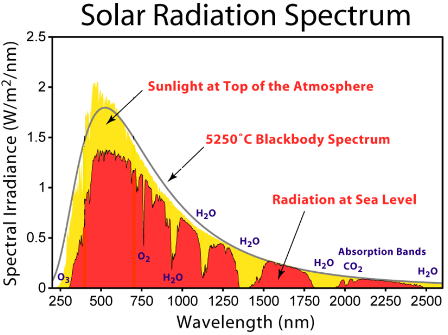Categories: Featured Articles » Interesting electrical news
Number of views: 11873
Comments on the article: 3
Nanoantennas - device, application, prospects for use
 An alternative device for converting the energy of solar radiation into electric current is often called a nanoantenna today, however, other applications are possible, and this will also be discussed here. This device works, like many antennas, according to the principle of rectification, but unlike traditional antennas, it works in the optical wavelength range.
An alternative device for converting the energy of solar radiation into electric current is often called a nanoantenna today, however, other applications are possible, and this will also be discussed here. This device works, like many antennas, according to the principle of rectification, but unlike traditional antennas, it works in the optical wavelength range.
The electromagnetic waves of the optical range are extremely short, but back in 1972 this idea was proposed by Robert Bailey and James Fletcher, who even then saw the prospect of collecting solar energy in the same way as with radio waves.
Due to the short wavelength of the optical range, the nanoantenna has dimensions not exceeding hundreds of microns in length (proportional to the wavelength), and in width - not more, or even less, 100 nanometers. For example, nanoantennas in the form of dipoles from nanotubes, for operation at frequencies of hundreds of gigahertz, belong to such antennas.
About 85% of the solar spectrum is composed of waves with a length of 0.4 to 1.6 microns, and they have more energy than infrared. In 2002, the Idaho National Laboratory conducted extensive research, and even built and tested nanoantennas for wavelengths ranging from 3 to 15 microns, which corresponds to photon energies of 0.08 to 0.4 eV.
It is in principle possible to absorb light from any wavelength using nanoantennas, provided that the antenna size is optimized accordingly. So, since 1973 to this day, research in the development of this direction has been continuously conducted.
In theory, everything is simple. Light incident on the antenna by oscillations of its electric field causes oscillations of electrons in the antenna with the same frequency as the frequency of the wave. After detecting the current with a rectifier, it is enough to convert it, and you can supply energy to power the load.
The theory of microwave antennas says that the physical dimensions of the antenna should correspond to the resonant frequency, but quantum effects make adjustments, for example, the skin effect at high frequencies is very pronounced.
At frequencies of 190-750 terahertz (wavelengths from 0.4 to 1.6 microns), alternative diodes are needed that are close to tunneling diodes based on metal-dielectric-metal, ordinary ones will not work, because huge losses will occur due to the action of stray capacitors. If successfully implemented, the nanoantennas will significantly overtake the currently popular solar panels in terms of efficiency, however, the problem with detection remains the main one.

In 2011, a group of physicists at Rice University developed a nanoantenna to convert near infrared radiation into current. The samples were a plurality of gold resonators arranged in an array at a distance of 250 nm from each other.
The dimensions of the resonator were 50 nm wide, 30 nm high, and the length ranged from 110 to 158 nm. The head of the research team, Naomi Galas, explained in a published article that differences in lengths correspond to differences in operating frequencies.
Gold elements were located on the silicon layer, and the contact point was just the Schottky barrier. An array of resonators was enclosed in a silicon dioxide layer, and the contacts were formed by a layer of indium tin oxide.
So, when light incident on the resonators, surface plasmons were excited - the electrons oscillated near the surface of the conductor, and when the plasmon decayed, then energy was transferred, which was then transferred to the electrons.
Hot electrons easily crossed the Schottky barrier, creating a photocurrent, that is, it turned out something similar to a photodiode.The height of the Schottky barrier made it possible to detect a range significantly exceeding the capabilities of silicon elements, but the achieved efficiency was only 1%.
In 2013, Brian Willis, a scientist from the University of Connecticut, USA, conducted a successful study and mastered the technology of atomic layer deposition. He also created an array of rectifying nanoantennas, but when the electrodes were finished cutting with an electron beam gun, the scientist coated both electrodes with copper atoms using atomic layer deposition to bring accuracy to distances of up to 1.5 nm.
As a result, the small distance created a tunnel junction so that the electrons could simply slip between the two electrodes under the influence of light, creating the conditions for further generation of current. This study is ongoing, and the expected efficiency can reach 70%.

In the same 2013, researchers from the Georgia Institute of Technology, USA, conducted simulations of nanoantennas from graphene. The goal here was to get antennas for exchanging data and creating networks for mobile devices. The key point is the use of surface electron waves on the surface of graphene, which occur under certain conditions.
Electron propagation in graphene has its own characteristics, so a small graphene-based antenna is able to radiate and receive at a relatively low frequency, but at a smaller size than a metal antenna. For this reason, Professor Iain Akiildiz pursues in this study precisely the goal of creating a new way of organizing wireless communications, rather than building solar cells.
Graphene electrons under the action of an electromagnetic wave coming from outside begin to emit waves that propagate exclusively on the surface of graphene, this phenomenon is known as a surface plasmon polarized wave (SPP wave), and allows you to build antennas for the frequency range from 0.1 to 10 terahertz.
In combination with transmitters based on zinc oxide, where the piezoelectric properties of these materials are used, a basis for wireless communication with low energy consumption is built up, and a data transfer rate of 100 times higher than existing wireless technologies is predicted.

In turn, scientists from the Saint-Petersburg Metamaterials Laboratory published an article “Optical nanoantennas” in 2013, where they showed the possibility of using optical nanoantennas for various purposes, including the transmission and processing of information at speeds significantly higher than current ones, since the photon is faster than electron, and this opens up fundamentally new directions.
The senior researcher at the laboratory, Alexander Krasnok, is sure that 5 millimeter chips that process up to terabit data in one second is only the beginning, and in the 21st century a real photon revolution awaits us.
Of course, scientists do not neglect the use of nanoantennas in other areas, such as medicine and energy. An extensive publication by the authors in the journal Uspekhi Fizicheskikh Nauk (June 2013, Volume 183, No. 6) provides an exhaustive review of the relative nanoantennas.
The economic effect of the introduction of nanoantennas is enormous. So, for example, in comparison with silicon photocells, the cost of one square meter of materials for nanoantennas is two orders of magnitude lower (silicon - $ 1000, an alternative - from $ 5 to $ 10).
It is highly likely that in the future, nanoantennas will be able to power electric cars, charge mobile phones, provide electricity to homes, and the silicon solar panels used today will become a relic of the past.
See also on this topic:Ultra-thin multilayer solar cells based on nanostructured materials
See also at bgv.electricianexp.com
:
